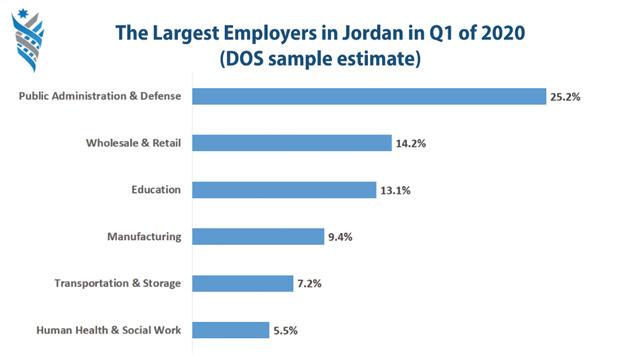You are here
‘Swelling’ unemployment rates necessitate urgent action — JSF paper
By JT - Jan 10,2022 - Last updated at Jan 10,2022
AMMAN — High unemployment rates have continued to pressure the Jordanian economy, but the COVID-19 pandemic has “taken an unprecedented turn”, said a policy paper published by the Jordan Strategy Forum (JSF) on Monday.
The overall unemployment rate has increased from 19.1 per cent in the third quarter of 2019 to 23.9 per cent in the same period of 2020, and to 23.2 per cent in the corresponding period in 2021, according to the report.
“These increases only escalate the economic cost, psychological cost, and the social cost of unemployment. Something must be done to stop this rising trend in unemployment,” read the report.
The report noted that “long before the onslaught of COVID-19, the overall unemployment rate was high”. COVID-19 has only exacerbated and exposed this long-existing challenge, said the report, citing the Department of Statistics.
The JSF report also said that the “age, gender, and education distribution of unemployment is a more serious challenge”, given the “record high” unemployment rates and atmosphere of uncertainty among youth, aged 15 to 24 years.
The paper found Jordan different from many countries in its labour force participation rate, especially considering the Kingdom’s low female labour participation rate at only 13.9 per cent.
The report noted that the supply side of the labour market is responsible for a large proportion of the unemployed in Jordan.
A large proportion of the unemployed Jordanians are with less than secondary education (192,185 individuals) and most are males, according to the report.
The number of registered expatriate workers has increased from 289,724 in 2006 to 348,736 by the end of 2019, the report said. This number is equivalent to 181.5 per cent of the unemployed Jordanians who have less than secondary education.
“This observation implies that there is a case for ‘replacing’ at least a proportion of the expatriate workers with Jordanians who have less than secondary education,” said the paper.
Commenting on the demand side of Jordan’s labour market, the report noted that the problem of the 158,294 unemployed Jordanians with a university degree is the demand side of the labour market, and not themselves/the supply side.
“In other words, it is the Jordanian economy’s growth rates which are not generating sufficient employment opportunities,” the report said.
The public administration and defence sectors are the largest employer of Jordanians (27.0 per cent), according to the report. The second and third largest employers of Jordanians are the wholesale and retail trade (14.4 per cent) and education (12.6 per cent) sectors.
The fourth largest sector in terms of employing Jordanians is manufacturing (10.4 per cent).
The report commented that the fact that there is a long-run relationship between economic growth and employment growth in manufacturing, and the value of this elasticity is relatively high is another reason why “manufacturing per se”, should be looked at as a “good sector” to reduce unemployment.
“Jordan faces a reckoning when it comes to the swelling numbers of the unemployed individuals. The hitherto existing unemployment rates require urgent attention,” the report said.
Related Articles
AMMAN — The Jordan Strategy Forum (JSF) anticipates that the unemployment rate among engineers in the Kingdom will probably increase if the
AMMAN — The Jordan Strategy Forum (JSF), in a policy brief, has called on all relevant stakeholders to look into the political and economic
AMMAN — COVID-19 has forced Jordanians to adapt to a “new normal” as the lockdown has introduced the government, private sector entiti
















